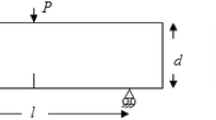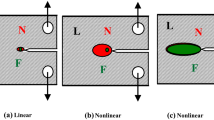Abstract
The main characteristics of the cohesive (or fictitious) crack model, which is now generally accepted as the best simple fracture model for concrete, are (aside from tensile strength) the fracture energies G F and G f corresponding to the areas under the complete softening stress-separation curve and under the initial tangent of this curve. Although these are two independent fracture characteristics which both should be measured, the basic (level I) standard test is supposed to measure only one. First, it is argued that the level I test should measure G f, for statistical reasons and because of relevance to prediction of maximum loads of structures. Second, various methods for measuring G f (or the corresponding fracture toughness), including the size effect method, the Jenq-Shah method (TPFM), and the Guinea et al. method, are discussed. The last is clearly the most robust and optimal because: (1) it is based on the exact solution of the bilinear cohesive crack model and (2) necessitates nothing more than measurement of the maximum loads of notched specimens of one size, supplemented by tensile strength measurements. Since the identification of material fracture parameters from test data involves two random variables, f′t (tensile strength) and G f, statistical regression should be applied. But regression is not feasible in the original Guinea et al.'s method. The present study proposes an improved version of Guinea et al.'s method which reduces the statistical problem to linear regression thanks to exploiting the systematic trend of size effect. This is made possible by noting that, according to the cohesive (or fictitious) crack model, the zero-size limit σN0 of nominal strength σN of a notched specimen is independent of F f and thus can be easily calculated from the measured f′t. Then, the values of σN0 obtained from the measured f′t values, together with the measured σN-values of notched specimens, are used in statistical regression based on the exact size effect curve calculated in advance from the cohesive crack model for the chosen specimen geometry. This has several advantages: (1) the linear regression is the most robust statistical approach; (2) the difficult question of statistical correlation between measured f′t and the nominal strength of notched specimens is bypassed, by virtue of knowing the size effect trend; (3) the resulting coefficient of variation of mean G f is very different and much more realistic than in the original version; (4) the coefficient of variation of the deviations of individual data from the regression line is very different from the coefficient of variation of individual notched test data and represents a much more realistic measure of scatter; and (5) possible accuracy improvements through the testing of notched specimens with different notch lengths and the same size, or notched specimens of different sizes, are in the regression setting straightforward. For engineering purposes where high accuracy is not needed, the simplest approach is the previously proposed zero-brittleness method, which can be regarded as a simplification of Guinea et al.' method. Finally, the errors of TPFM due to random variability of unloading-reloading properties from one concrete to another are quantitatively estimated.
Similar content being viewed by others
References
Bažant, Z.P. and Li, Z. (1996). Zero-brittleness size-effect method for one-size fracture test of concrete. J. of Engrg. Mechanics ASCE 122 (5), 458–468.
Bažant, Z.P. and Oh, B.-H. (1983), Crack band theory for fracture of concrete. Materials and Structures (RILEM, Paris) 16, 155–177.
Bažant, Z.P. and Pfeiffer, P.A. (1987). Determination of fracture energy from size effect and brittleness number. ACI Materials Journal 84, 463–480.
Bažant, Z.P. and Planas, J. (1998). Fracture and Size Effect in Concrete and Other Quasibrittle Materials. CRC Press, Boca Raton and London (Sections. 9.2, 9.3)
Benjamin, J.R. and Cornell, C.A. (1970). Probability, Statistics and Decision for Civil Engineers. McGraw-Hill Book Co., New York.
Cottrell, A.H. (1963). Iron and Steel Institute Special Report 69, p. 281.
Elices, M., Guinea, G. V. and Planas, J. (1992) Measurement of the fracture energy using three-point bend tests: Part 3—Influence of cutting the P δ δ tail. Materials and Structures, 25, 327–334.
Elices, M., Planas, J. and Guinea, G.V. (1993). Modeling cracking in rocks and cementitious materials. Fracture and Damage of Concrete and Rock, (edited by Rossmanith, H.P.), E & FN Spon, London, pp. 3–33.
Elices, M. and Planas, J. (1996). Fracturemechanics parameters of concrete, an overview. Advanced Cement-Based Materials 4, 116–127.
Gettu, R., Bažant, Z.P. and Karr, M.E. (1990). Fracture properties and brittleness of high-strength concrete. ACI Materials Journal 87 (Nov.-Dec.), 608–618.
Guinea, G.V., Planas, J. and Elices, M. (1992) Measurement of the fracture energy using three-point bend tests: Part 1—Influence of experimental procedures. Materials and Structures 25, 212–218.
Guinea, G.V., Planas, J. and Elices, M. (1994a). Correlation between the softening and the size effect curves. Size Effect in Concrete Structures. (edited by Mihashi, H., Okamura, H. and Bažant, Z.P.), E&FN Spon, London, pp. 233–244.
Guinea, G.V., Planas, J. and Elices, M. (1994b). A general bilinear fitting for the softening curve of concrete. Materials and Structures 27, 99–105 (also summaries in Proc., IUTAM Symp., Brisbane 1993 and Torino, 1994).
Guinea, G.V., Elices, M. and Planas, J. (1997). On the initial shape of the softening function of cohesive materials. Int. J. of Fracture 87, 139–149.
Haldar, A. and Mahadevan (2000). Probability, Reliability and Statistical Methods in Engineering Design. J. Wiley, New York.
Hillerborg, A., Modéer, M. and Petersson, P.E. (1976). Analysis of crack formation and crack growth in concrete by means of fracture mechanics and finite elements. Cem. and Concr. Res. 6, 773–782.
Guinea, G.V., Planas, J. and Elices, M. (1994). Correlation between the softening curve and the size effect curves. Size Effect in Concrete Structures, (edited by Mihashi, H., Okamura, H. and Bažant, Z.P.), E & FN Spon, London, pp. 233–244.
He, S., Plesha, M.E., Rowlands, R.E. and Bažant, Z.P. (1992). Fracture energy tests of dam concrete with rate and size effects. Dam Engineering 3 (2), 139–159.
Hillerborg, A., Modéer, M. and Petersson, P.E. (1976). Analysis of crack formation and crack growth in concrete by means of fracture mechanics and finite elements. Cem. Concr. Res. 6, 773–782.
Hillerborg, A. (1983). Examples of practical results achieved by means of the fictitious crack model, in Preprints, Prager Symp. on Mechanics of Geomaterials: Rocks, Concretes, Soils, (edited by Bažant, Z.P.), Northwestern University, Evanston, pp. 611–614.
Hillerborg, A. (1985a). The theoretical basis of method to determine the fracture energy G f of concrete. Materials and Structures 18 (106), 291–296.
Hillerborg, A. (1985b). Results of three comparative test series for determining the fracture energy G f of concrete. Materials and Structures 18 (107).
Jenq, Y.S. and Shah, S.P. (1985). A two parameter fracture model for concrete. Journal of Engineering Mechanics 111(4), 1227–1241.
Kfouri, A.P. and Rice, J.R. (1977). Elastic-plastic separation energy rate for crack advance in finite growth steps. Fracture 1977 (Proc., 4th Int. Conf. on Fracture, ICF4, Waterloo), (edited by Taplin, D.M.R.), Univ. of Waterloo, Ontario, Canada, Vol. 1, pp. 43–59.
Knauss, W.C. (1973). On the steady propagation of a crack in a viscoelastic sheet; experiment and analysis. The Deformation in Fracture of High Polymers, (edited by Kausch, H.H.), Plenum, New York, pp. 501–541.
Knauss, W.C. (1974). On the steady propagation of a crack in a viscoelastic plastic solid. J. of Appl. Mech. ASME 41 (1), 234–248.
Leonov, M.Y. and Panasyuk, V.V. (1959). Development of a nanocrack in a solid (in Russian). Prikladnaya Mekhanika (Soviet Applied Mechanics) 5 (No. 4), 391–401; English translation in A tropical encyclopedia of current knowledge (edited by G.P. Cherepanov), Krieger Publ., Malabur, FL (1998).
Nallathambi, P. and Karihaloo, B.L. (1986), Determination of specimen-size independent fracture toughness of plain concrete. Mag. of Concrete Res. 38 (135), 67–76.
Nakayama, J. (1965). Direct measurement of fracture energies of brittle heterogeneous material. J. of the Amer. Ceram. Soc. 48 (11).
Palmer, A.C. and Rice, J.R. (1973), The growth of slip surfaces on the progressive failure of over-consolidated clay. Proc. Roy. Soc. Lond. A. 332, 527–548
Petersson, P.E. (1981). Crack growth and development of fracture zones in plain concrete and similar materials. Report TVBM-1006, Div. of Building Materials, Lund Inst. of Tech., Lund, Sweden.
Planas, J., Guinea, G.V. and Elices, M. (1993). Softening curves for concrete and structural response. Fracture and Damage of Concrete and Rock, (edited by Rossmanith, H.P.), E & FN Spon, London, pp. 66–75.
Planas, J., Guinea, G.V. and Elices, M. (1997). Generalized size effect equation for quasibrittle materials. Fatigue and Fracture of Engineering Materials and Structures 20 (5), 671–687.
Planas, J., Guinea, G.V. and Elices, M. (1999). Size effect and inverse analysis in concrete fracture. Intern. J. of Fracture 95, 367–378.
Planas, J., Elices, M. and Guinea, G.V. (1992) Measurement of the fracture energy using three-point bend tests: Part 2—Influence of bulk energy dissipation. Materials and Structures 25, 305–312.
Rice, J.R. (1968). Mathematical analysis in the mechanics of fracture. Fracture—An advanced treatise, Vol. 2, (edited by Liebowitz, H.), Academic Press, New York, pp. 191–308.
RILEM (1985) Recommendation TC 50-FMC. Determination of fracture energy of mortar and concrete by means of three-point bend tests of notched beams. Materials and Structures 18 (106), 285–290.
RILEM (1990a) Recommendation TC 89-FMT. Size effect method for determining fracture energy and process zone of concrete. Materials and Structures 23, 461–465.
RILEM (1990b) Recommendation TC 89-FMT. Determination of fracture parameters (Ks I and CTODc) of plain concrete using three-point bend tests. Materials and Structures 23, 461–465.
Rocco, C.G. (1996). Influencia del Tamaño y Mecanismos de Rotura del Ensayo de Compresión Diametral. Doctoral Thesis, Universidad Politecnica de Madrid, Spain.
Smith, E. (1974). The structure in the vicinity of a crack tip: A general theory based on the cohesive crack model. Engineering Fracture Mechanics 6, 213–222.
Tang, T., Bažant, Z.P., Yang, S. and Zollinger, D. (1996). Variable-notch one-size test method for fracture energy and process zone length. Engineering Fracture Mechanics 55 (3), 383–404.
Tattersall, H.G. and Tappin, G. (1966). The work of fracture and its measurement in metals, ceramics and other materials. J. of Mater. Sci. 1 (3), 296–301.
Wells, A.A. (1961). Unstable crack propagation in metals-cleavage and fast fracture. Symp. on Crack Propagation, Cranfield, Vol.1, 210–230.
Wittmann, F.H., Rokugo, K., Brühwiller, E., Mihashi, H. and Simopnin, P. (1988). Fracture energy and strain softening of concrete as determined by compact tension specimens. Materials and Structures (RILEM, Paris) 21, 21–32.
Wnuk, M.P. (1974). Quasi-static extension of a tensile crack contained in viscoelastic plastic solid. J. Appl. Mech. ASME 41 (1), 234–248.
Author information
Authors and Affiliations
Corresponding author
Rights and permissions
About this article
Cite this article
Bažant, Z.P., Yu, Q. & Zi, G. Choice of standard fracture test for concrete and its statistical evaluation. International Journal of Fracture 118, 303–337 (2002). https://doi.org/10.1023/A:1023399125413
Issue Date:
DOI: https://doi.org/10.1023/A:1023399125413




